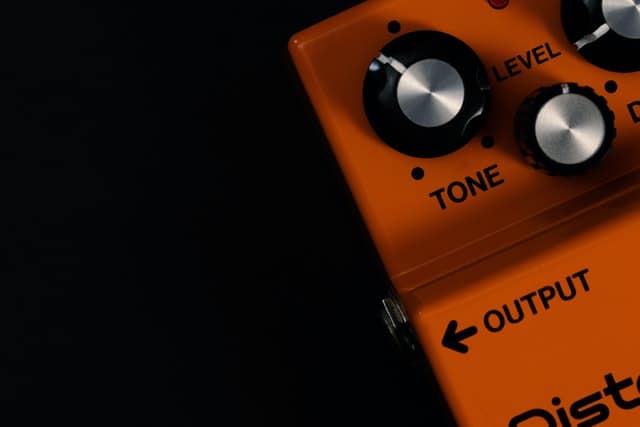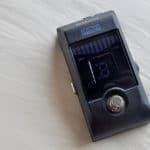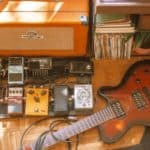The concept of “True Bypass” is not an old one, compared to the buffered pedals that have existed since stompboxes were created.
For the most part, players have sworn by this technology as a means of preventing tone loss from your signal chain.
But, does that mean that buffered pedals no longer have a place?
Or do they offer something that can help?
Buffered pedals and true bypass pedals both have their pros and cons, and there are a few quick things you can do to identify either type, either by their switches, or how they handle your signal when power is cut. Both also play an important part in your signal chain and can be used strategically to ensure you have the best signal possible
So, let’s get right down to it!
What’s the difference between a true bypass and a buffered pedal?
The major difference lies in the circuitry.
Buffered pedals contain chips that contain tiny amplifiers that boost your signal slightly.
This allows your signal to remain strong and prevent high-end loss while going through long cable runs.
These pedals are also “always on” in the sense that your guitar signal is going through the circuits, even when the pedal is off, affecting your sound.
However, because the signal isn’t cut out of your chain, certain reverb and delay pedals will spill over when they’re switched off, finishing off the effect rather than stopping abruptly.
True bypass pedals remove the pedal’s circuit from your signal chain when they’re off.
This essentially means that when the pedal is on, your signal goes through the effect, and when it’s off, it’s like the pedal isn’t there.
Many players enjoy true bypass as a means of preserving their guitar’s original tone when not using effects.
Also, when a true bypass pedal is switched off, the effect immediately cuts off, including delay and reverb trails.
Are true bypass pedals better?
The answer depends on your setup.
Some people do find true bypass better since it eliminates the circuit from your signal when not in use.
The other advantage to true bypass pedals is that if you have a power failure to that pedal, your signal will still go to your amp with the pedal off thanks to the direct connection.
The problem with true bypass is that while it does remove the circuit, you’re still adding some capacitance to your chain by stringing these pedals together (almost akin to using a longer cord).
In short, you are still adding distance between your guitar and your amp. Your signal will still get a bit weaker, affecting your overall tone.
Are all tuner pedals buffered?
It depends on the pedal. Some are, some are not, and some give you the option.
Take the Boss TU-3 (a very popular pedal tuner).
That pedal, like most – if not all – Boss pedals have very good buffers built into them.
Like most tuners, they work best when it’s one of the first pedals in your chain. Just be aware that because it is buffered, it may cause problems with “early-chain” pedals (such as old fuzz pedals) that don’t take too kindly to them.
For true bypass, there is the TC Electronic Polytune.
The early models of these pedals do have true bypass switching in them.
This eliminates the tune from the signal when it’s turned off, and the lack of buffer makes it more “fuzz” friendly (if you will).
Now, the more recent versions of the Polytune feature a Bonafide Buffer circuit integrated into the pedal (the Bonafide Buffer is a switchless, “always on” device that you added to your signal chain where you needed a buffer).
This feature allows you to add a buffer to the tuner if needed. However, if you turn on the tuner, your signal will constantly run through the circuit, taking away the true bypass feature.
How to know if a pedal is buffered or true bypass?
The easiest way to know if your pedal is a true bypass one or not is to plug it into your signal chain, then unplug the power to the pedal.
If your signal still goes through, then you have a true bypass pedal.
Another way to know is if your pedal has a 3PDT switch, which usually is solid and produces a loud click.
That may be an indication, but is not always reliable (TC uses soft-touch switches in their pedals, whether true bypass or not).
Most builders such as Boss, Ibanez, and Maxon, make pedals with quality buffers.
However unplugging the power to these pedals while in use will mean your signal will get cut off, whether the pedal is on or off.
Should you worry about what type your pedal is?
If you’re using just a few pedals in your setup, there is less need to worry about the type of pedal that you’re using.
If you’re creating a big, elaborate pedalboard, you may want to plan to balance the use of buffers (whether they’re in pedals or standalone devices) with true bypass pedals.
Because of the added distance, you’re putting between guitar and amp, a buffered pedal here or there (particularly at the start and end of your signal chain) will make sure you have a strong signal throughout.

Hello there, my name is Ramiro and I’ve been playing guitar for almost 20 years. I’m obsessed with everything gear-related and I thought it might be worth sharing it. From guitars, pedals, amps, and synths to studio gear and production tips, I hope you find what I post here useful, and I’ll try my best to keep it entertaining also.





